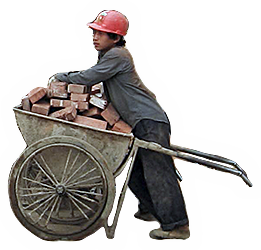The Rise and Fall of Boten Golden City
Driven by mere curiosity in March 2010 I made my way from Oudomxay up to the Chinese border at Boten (also: Botene, Ban Botene, Ban Botèn, Batene, Bo Tena). Border towns are particularly interesting, for often so many shady things are going on in them. Boten was a surprise of the extra class. It turned out being a new city in the making with huge house blocks, shops, karaoke bars, hotels and, above all, casinos.
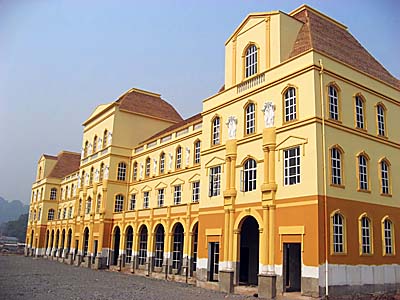
Brandnew ruins: not yet fully ready, soon given up. Late capitalism with it's huge amount of 'unemployed' money is no more profitable in the producing sector. Therefore the weirdest business ideas in grand style are performed. After all it's not only a big damage for the nature but also a big waste of resources. Image by Asienreisender, 3/2010
Although none of the buildings was yet fully ready, some were already operating - namely Royal Jinlun hotel/casino complex and some other places and casinos. Boten was a comparable place to the Chinese casinos on an island in the Mekong River at the Golden Triangle near Chiang Saen - but much bigger in size. Another comparable project of the kind is undergoing on Bokor Mountain in south Cambodia, where a whole new casino city is under construction, designed for a 100,000 inhabitants.
'Boten Golden City' is an example for Chinese expansion into little Laos. It's the most important border crossing between China and Laos, being declared a 'Special Economic Zone' in 2002 and soon after leased by a Chinese investor from Hong Kong. The spot is situated at both the national road no. 13, connected to Kunming/China crossing the whole of Laos down to the Laotian/Cambodian border at Veun Kham/Dong Calor. Moreover it's also placed on the route no. 3, which is linking now China with Thailand via the new bridge over the Mekong River at Houayxay/Chiang Khong and therefore part of the Asian Highway Project (AH). So, traffic will be boosted, and Boten was designed as a rest place for drivers, as a commercial hub and, more than that, as a gambling center for Chinese who are not allowed to gamble in China (except Macau). Laotians, by the way, are also not allowed to gamble in Laos.
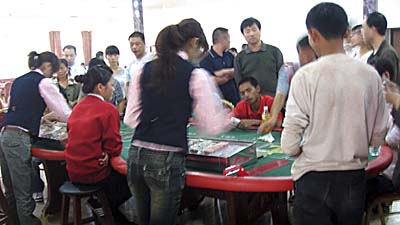
Inside one of the casinos. Gambling as a source of income and wealth. There were many smaller operators who got a concession for a casino. And one thing is sure: the casino always wins. Image by Asienreisender, 3/2010
Quickly the 26km2 large area got covered with concrete and asphalt, massive construction sites sprang up everywhere in the green, hilly surroundings. A busy Chinese economic colony was booming, with Chinese construction workers, electricity and telephone infrastructure from China, Mandarin Chinese dominantly spoken, Chinese currency preferred and a flood of Chinese prostitutes at work. Beer and cigarettes were Chinese, the time set to Beijing time and Chinese nationals could pass the border without a visa. Shops spread out selling pornographic material, sex potions and so called 'Chinese medicines', made from ingredients of the most different animals, many of them on the brink of extinction. Further planned was an airport, a golf course, and a convention center. 'Boten Golden City' was planned to become the most modern, internationalized city in Laos. There was even a private police, a security force established - presumably in fact rather a gang of gangsters and gunmen. Boten became for a time a lawless Chinese exclave in Laos.
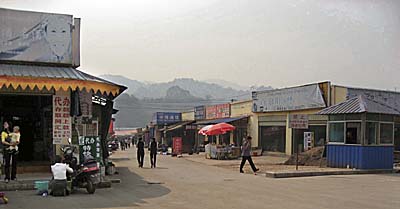
A piece of China in Laos. Beside of the many big buildings a lot of smaller shops opened in Boten. Everything here is written in Chinese script. At the right there is a police box. Now all the shops are closed and the casino city is practically a ghost town. Image by Asienreisender, 3/2010
But the gambling heaven didn't last long. Not only prostitution and drugs come with gambling, also violence and bancrupcy. Some people couldn't balance their debts and were held hostage after not paying their bills and losses, according to media reports. Rumours about corpses in the nearby river appeared. People who were lured into the casinos by promises of free transport and accommodation and a loan for gambling money were never seen again after. The Laotian government was urged by the Chinese authorities to shut the casinos down (April 2011). The death verdict for the casino city was the cancellation of granting a visa-free entrance to Boten. The customers stayed away, the development collapsed, and all the many new inhabitants left the place again. The workers, the prostitutes, a Thai transvestite show - they all went out again. Of the estimated 10,000 people living here in the peak time of the boom are merely 2,000 left. The 'Special Economic Zone' was degraded to a 'Specific Economic Zone' - what allows more governmental influence and restrictions for the local business. Rapidly emerging Boten, still unfinished, declined to a casino ghost town.
New investment is ned for the future of Boten. A year after the shutdown the same investor from Hong Kong together with another Chinese company from Yunnan made a new contract with the Laotian government (April 2012). It's now about changing the project into a 'commercial and tourist operation'. But still there seems to be no new impulses for the place. The shopping centers and hotels are mostly without customers, as most of the smaller shops and restaurants, so far they are open anyway.

A big building boom. Imagine, shortly before all this was still rainforest. A year later all got shut down.
Images and photocomposition by Asienreisender, 2010/2014
Development and Land Grabbing
Altogether there are more than 2,000 land concessions given to foreign investors in Laos alone. The weak and poor landlocked country allegedly needs urgently 'development' and investment. The much richer neighbouring countries China, Thailand and Vietnam are particularly eager to exploit Laos' resources. 'Global Witness' issued a report in 2013 on land grabbing practices of two Vietnamese companies in Laos and Cambodia. The practices described there are exemplarily. In the background are also powerful western investors involved, like the Deutsche Bank. Click the link above and you will find also a download for the report (free).
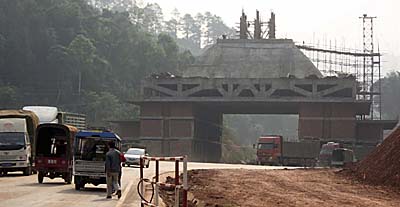
The Laotian-Chinese border checkpoing. Another big gate was here under construction. Image by Asienreisender, 3/2010
To build 'Golden Boten City Ltd.' the people who lived there before had to leave the place. Also other villages in the area around have been cleared from the former inhabitants, where Chinese investors grow rubber or tobacco now. The displaced people are now bereaved of their farmland and an income. Although some might have got a compensation, they had no choice but to go. According to reports of interviews with people in 'new Boten', what lies some 20km away, they would rather like to go back.
Forbes writes on it's website that the central figure behind 'Golden Boten City Ltd.' is Huang Ninxuan, 56, an influential man with a Hong Kong citizenship, who ran other casinos in Burma/Myanmar before. According to Huang himself, there were roughly around $US 250 million spent for the project. It's obscure where the money was coming from. The second investor, Taiwanese George Huang, 55, said that several investments came from Thailand, Singapore, the UK, Russia and the Ukraine. At the time Forbes wrote the article about (July 2011), Huang was not to speak and his location was unclear.
Checking the background of the investors in Hong Kong, Forbes found merely kind of postbox companies who are covered by the authorities in Hong Kong (no further information).
The 'South China Morning Post' pointed out that
![]() a significant number of Hong Kong companies don't have actual people serving as directors, using corporate entities instead. They provide perfect vehicles for fraud, money-laundering and the financing of terrorist arms, among other crimes.
a significant number of Hong Kong companies don't have actual people serving as directors, using corporate entities instead. They provide perfect vehicles for fraud, money-laundering and the financing of terrorist arms, among other crimes.![]()
Source: http://www.forbes.com/sites/robertolsen/2013/03/27/hong-kong-invites-fraud-to-solve-nonexistent-problem/
Unclear remain also the circumstances why the Laotian authorities allowed the project, how much money flew for the concessions (annually between US$ 700.000 and US$ 2.4 million, according to a Thai professor in Chiang Mai). Related Laotian officals declined to comment.
Laos has at the time ten 'Special Economic Zones' and is planning thirty more, 25 of them realized until 2020.
Also the great number of planned, under construction and already running hydroelectic dams in Laos are only possible with massive support from foreign investors and technological know-how from abroad.
